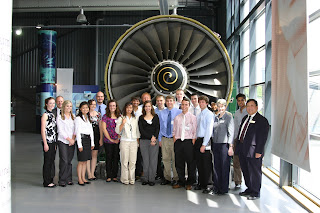
It's Monday of our final week in Oxford. It's difficult to believe the program is nearly over. While we've been here for a while, we've kept ourselves very busy with class, homework, site visits, and travel. As anticipated, there hasn't really been enough time to do and see everything there is to do and see.
This morning started early. We met around 6.30 for our two-hour bus trip to Derby for the Rolls-Royce visit. Rolls-Royce is a world leader in providing integrated power systems for use on land, at sea, and in the air. In addition to their civil aerospace, defense aerospace and marine businesses, they have a growing business in the energy sector. Beyond their traditional manufacturing business, they are also growing as a service provider.
Rolls-Royce really provided an outstanding experience. We were met with a team of presenters who gave us an overview of the company as well as presentations on global supply chain and Human Resource considerations in a global environment. Before long we left the Learning and Career Development Center for the New Engine Assembly & Test Facility. Here we learned about the various large aircraft engines manufactured by Rolls-Royce, and then toured the plant floor where we saw a number of engines in production. The factory floor was a surprisingly clean and flexible space, where they produce about six engines per week, although they are considering strategic ways to shorten the production time for a single engine. Before leaving the assembly area, we learned a little about engine testing and certification standards.
Our next stop was the HP Blade Facility, where Rolls-Royce manufactures 16 types of turbine blades for their aircraft engines. In contrast to the assembly plant, this fairly new facility was noisy and highly automated. The blades are crafted with incredible precision. They are infused with patterns of microscopic holes which help the blades withstand engine temperatures of 1700 degrees Centigrade. Placement of the holes is checked with a precise magnifying camera. Each blade is inscribed with a tiny, three-dimensional dot matrix code which identifies not only the part and its date and time of manufacture, but also information about the machine operators and their work schedule.
After leaving the Blade Facility, we returned to the Learning and Career Development Center, where we enjoyed a lunch at the Rolls-Royce Heritage Center. Everyone enjoyed seeing some of the engines manufactured by Rolls-Royce during the past 100 years and reading about the company's many achievements. We were able to take some group photos before leaving the Rolls-Royce campus.

Next we drove through downtown Derby to take a quick look at the birthplace of the Industrial Revolution before heading to nearby Donington Park. At Donington Park, we were given a private guided tour of the Grand Prix Exhibition, which is the largest collection of Grand Prix racing cars in the world. Our guide, a professional driver and racing instructor, was quite knowledgeable of the facility, cars, and drivers. The museum included more than we could possibly take in during one visit. And to make us feel more at home, there were several Indy cars within the collection.

We made it back to St. Catz about 11.5 hours after we started, and we were a tired group. But it wasn't time to relax: tomorrow is exam two, and the following day is the group presentations. It's crunch time!

No comments:
Post a Comment